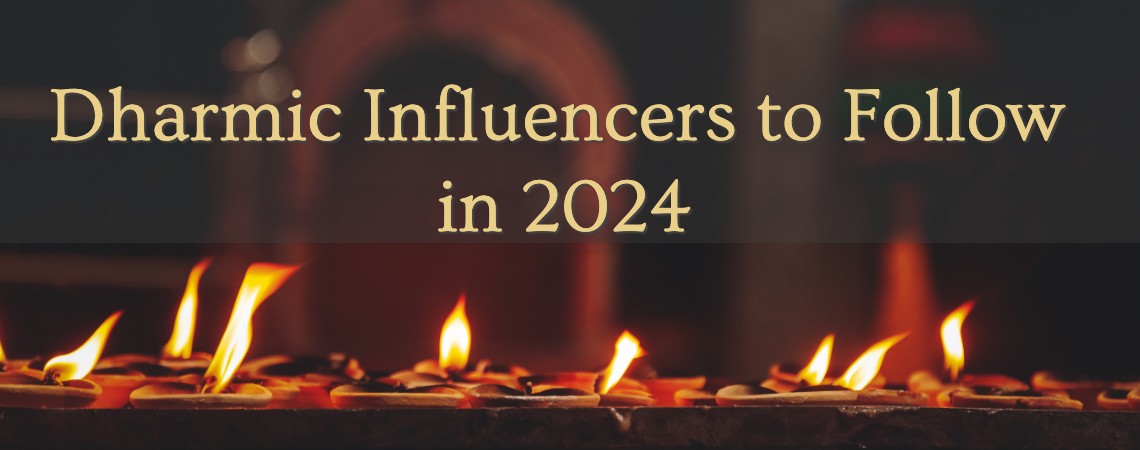
In the dynamic landscape of social media and digital influence, many Hindus have started spreading awareness through various social media channels. These individuals, diverse in their backgrounds and expertise, are not merely content creators but catalysts for change. They use their voices to amplify Hindu heritage along with its scientific and spiritual achievements, counter misinformation, and advocate for Dharmic causes.
In exploring the stories and endeavors of these influencers, it becomes evident that their collective efforts contribute to a richer, more enlightened understanding of Sanatana Dharma while setting the record straight on common misinformation spread across global media outlets.
* Please note the order in which they appear is only due to the order in which they responded to the questions. In addition, this list is not meant to be exhaustive by any means.*
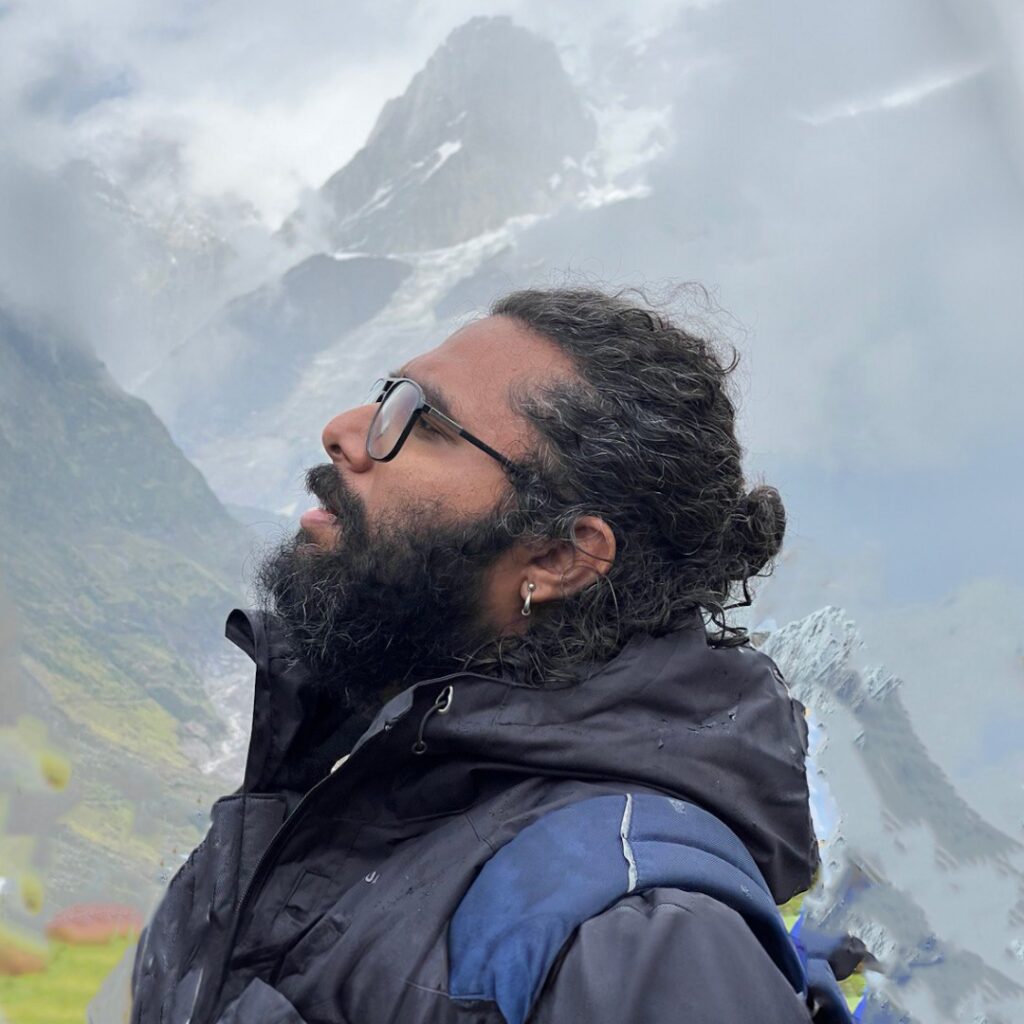
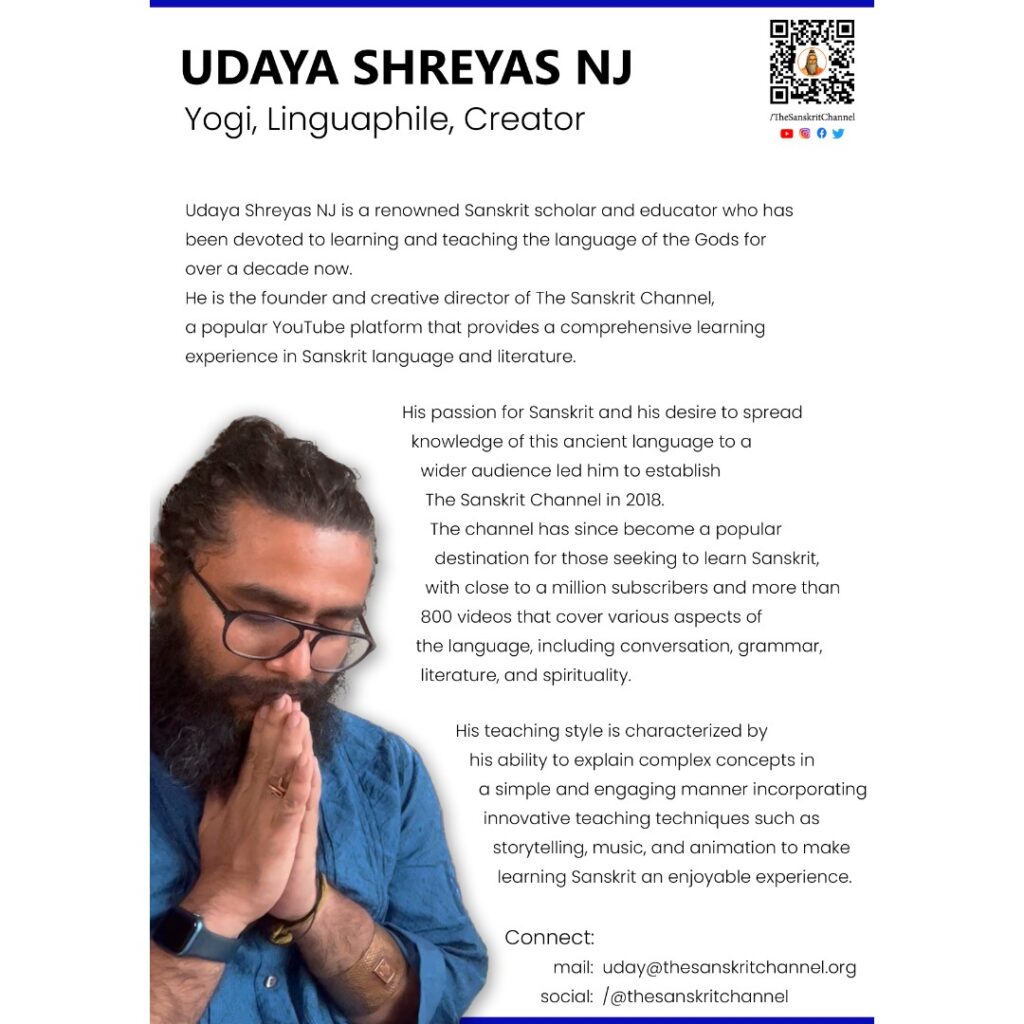
Udaya Shreyas
Founder, The Sanskrit Channel
1) What inspired you to start sharing about Sanatana Dharma and India’s rich cultural history on social media?
Since childhood, I’ve always been passionate about languages. This passion led me towards learning Sanskrit as a hobby once I ‘settled’ into a job, and found time to invest time and energy in pursuits other than academics. Sanskrit language acted as a doorway for me that opened up a whole new world of Kavyas, and Shastras across a broad range of topics.
Once I discovered Adhyatma through Yoga Shastra, my priorities in life shifted. I quit my job and spent a few years equipping myself with Sadhana to deepen my understanding and experience of the source of all this Knowledge: Santana Dharma, and the Civilization that is Bharat. I have since then been trying to present my own learnings to others like me who might find value in this, in a way that my past self would have benefitted from.
2) How do you use social media to promote positive discussions about Hinduism and counter misconceptions?
My top priority has been to base my content on authentic references from Sanskrit sources. The second important step is to look at these texts with a first-principles thinking. Many coloured-perspectives and unqualified-opinions have affected the translations of many of our texts. This needs to be changed. Bharatiyas need to be skilled-up to be able to read, and understand Sasnkrit texts on their own without a need for translations into other languages.
It is my approach that instead of fighting every misconception out there, be it about Jyotisha, Tantra, Vastu or whatever else, it is better to present authentic literature, and make it understandable to everyone. This will naturally take care of gimmick-peddlers or nay-sayers at once.
3) What role do you see social media playing in preserving and promoting traditional Hindu practices, especially among the younger generation?
Social media acts as a bridge, connecting the younger generation with the richness of traditional Hindu practices. It is a platform that connects people at scale. It has the power to make information available globally, instantly. Apart from that, I think it is agnostic to preserving, or promoting anything on its own. The onus is on us, to put out the right kind of content.
4) Do you collaborate with other influencers or organizations to amplify your message, and how do these collaborations contribute to the larger conversation about Hinduism on social media?
Absolutely.
I keep collaborating with regional language experts, Sketching artists, Classical Musicians, Dancers, Linguists, and Sanskrit Institutes to explore common themes and create a broader palette of content for my audience to consume. It is not happening at scale yet among all entities working in Indic fields.
Universities, art institutes, individual scholars, and artists across all fields need to team up to create better content showcasing concepts of Sanskrit, and Samskriti. Unfortunately, most of these components are still working in silos, or are reluctant to adapt to the changing times, leveraging technological tools and platforms.
5) In your opinion, what are some common misconceptions about Hinduism that you aim to dispel through your content?
Where do I even start! In this world where there are many forces at play, it becomes a losing battle to tackle misconceptions one by one.
You handle one, vested interests could cook-up ten more.
It is rather prudent to focus our efforts on presenting the right concepts, in a captivating manner. Once the fundamentals of what Sanatana Dharma is, how vast and profound its understanding of life, and the self is, and what makes it ‘eternal’ in the first place, are all clear, I think we would be much more successful in tackling misconceptions from arising even.
6) Have you faced any challenges or controversies related to sharing your Hindu identity on social media, and how did you handle them?
Nothing that has been a major hindrance. There is so much work to be done, and so much progress to be made even in areas where I get no resistance, that I haven’t concerned myself yet with places where there is resistance to me/my content.
The bigger challenge I face is in fact bringing people who already share the same ideas, but are either unskilled or unwilling to work together in an efficient manner for a plethora of reasons. I’m busy working to bring about a change here.
7) What are your future goals for your social media presence in terms of promoting Hindu culture & values?
1) Build a network of content researchers, editors, and artists to make content at scale.
2) Create more quality content in the regional languages of Bharat.
3) Adapt to changing formats of content consumption like VR/AR.
4) Provide this framework to budding Sanskrit researchers who aspire to decode authentic concepts of Sanskrit Language and literature.
8) What advice do you have for others who want to use social media as a platform to promote Sanatana Dharma?
a. Research: Stay true to authentic references and make sure enough research goes behind your content.
b. Packaging: Present your research in a manner that is gripping and engaging to your audience.
c. Collaboration: Collaborate with like-minded influencers to amplify your message.
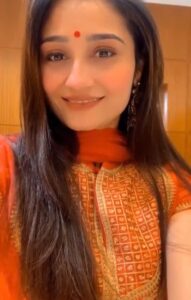
Akanksha- Youngndharmic
1) What inspired you to start sharing about Sanatana Dharma and India’s rich cultural history on social media?
I observed instances of both hatred and ignorance toward Hinduism within educated Hindus in my social circle. It struck me that if adults lacked fundamental knowledge about their own culture, traditions, and rituals, they might struggle to pass on this knowledge to their children. Consequently, I initiated my efforts by focusing on teaching Hinduism to kids, which remains my primary objective. However, I noticed a growing interest among young adults in my content, particularly related to debunking myths about Hinduism. This interest has significantly influenced my contributions on social media.
2) How do you use social media to promote positive discussions about Hinduism and counter misconceptions?
I specialize in creating concise and to-the-point video content, typically lasting 1-2 minutes, tailored to cater to the short attention spans of today’s audiences. In my videos, I cover a wide range of topics, such as the significance of temples, the deeper meanings behind festivals, the interpretations of words like “rasaleela,” and stories from Hindu scriptures like the Puranas, Ramayana, and Mahabharata. Through each video, my goal is to promote awareness of the profound teachings within Hinduism and debunk myths surrounding misrepresented aspects of the religion.
3) What role do you see social media playing in preserving and promoting traditional Hindu practices, especially among the younger generation?
In ancient times, individuals would journey to Kashi to acquire knowledge about Hinduism or Dharma in a broader sense. This is how figures such as Tulsidas ji and Buddha were able to disseminate their teachings. In today’s world, the advent of Social Media has significantly simplified the dissemination of the timeless teachings and captivating stories of Hinduism, not only to Hindus but to a global audience. My only piece of advice would be to exercise caution and verify the scriptural basis of the content shared by any influencer or account before following them. Just like any other medium, Social Media can also be a platform for unverified or inauthentic information.
4) In your opinion, what are some common misconceptions about Hinduism that you aim to dispel through your content?
My primary goal is to instill a sense of pride in people and then dispel myths. It’s evident that the world is increasingly recognizing and benefiting from our systems like Yoga, Meditation, and environmentalism, while some of our youth are drawn towards alcohol, weed, and pornography. My belief is that if we truly grasp the essence of Hinduism, it will inspire us to become more productive and compassionate individuals – at least that has been my personal journey thus far.
Through my work, I also aim to help people delve into the deeper meanings behind our Kathas (narratives). I want to shed light on various aspects, such as the significance of cows, Varnashram (the system of social classes), and the distinction between Stree Dhan (a woman’s property) and Dowry. These are just a few of the many topics I aspire to highlight.
5) Have you faced any challenges or controversies related to sharing your Hindu identity on social media, and how did you handle them?
Certainly, I’ve experienced doxxing by left-leaning groups, which is why I had to eliminate all my personal information from the internet. My work and my family were both facing serious threats as a result.
6) What are your future goals for your social media presence in terms of promoting Hindu culture & values?
If I had the support of investors, I would be enthusiastic about producing short films for children. My primary goal is to impart Dharmic values to the younger generation. Currently, I am working independently, but I hope to seize opportunities to expand this endeavor into a platform where I can narrate our Itihas and Puranas to children in the most captivating and educational manner possible.
7) What advice do you have for others who want to use social media as a platform to promote Sanatana Dharma?
In a world where negativity often grabs attention quickly, it’s important to remember that if you want to contribute to Dharma, do it as a service rather than for the sake of popularity. Instead of producing provocative content, focus on creating educational material. Eventually, you’ll discover an audience that values such content as well.
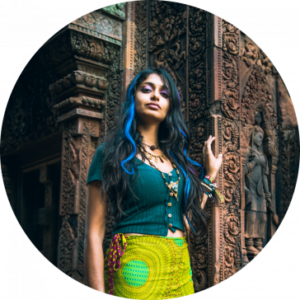
Kamya Buch
1) What inspired you to start sharing about Sanatana Dharma and India’s rich cultural history on social media?
My spiritual journey started in 2011 when I went through a difficult period of clinical depression and discovered natural health and spiritual practices, met my Guruji in India and was able to heal myself completely using natural holistic methods. After completing my Masters degree, I travelled across the world to experience more of my own and other global ancient cultures by myself. I started my travel blog Wandering Kamya in 2017 and have been a digital nomad since then, creating content and curating experiences around healing, travel and spirituality.
It was in 2020 that I realised the socio-political and historical scenario of Hindu civilisation; from the the suppression of our on-going genocide, the erasing of our ancestral lineages, loss of our ancient ecosystems, traditions and various issues. Both colonisation as well as ‘neo-colonisation’ which often comes under the guise of ‘economic development.’
This motivated me to share more about Sanatan Dharma traditions and the rich history of our ancient civilisation which is a spiritual lighthouse for the world.
2) How do you use social media to promote positive discussions about Hinduism and counter misconceptions?
There are many misconceptions in the modern world about Hinduism, from the idea that it is just a ‘way of life’ or cultural identity; when in fact we have multiple indigenous Sampradayas (sects), ancestral lineages and jatis, vaam marg, dakshin marg, and various characteristics that define the traditions, knowledge systems and identities of the last ancient living civilisation on earth. 1000+ years of colonisation has disconnected us from our roots and taught us to demonise our own knowledge systems and ancestry.
Vedic Sanatan Dharma provides the most sophisticated and profound systems of expanding one’s consciousness, and therefore it is my aim to share information from the traditional origins as well as my own experiences and the spiritual science behind our practices.
I believe that Hindus need to be empowered, from their self-esteem and the inner work domain to the external and economic domain. I am a strong believer in the power of community, and hold weekly Sanskrit shloka chanting sessions on zoom in addition to my on-going spiritual workshops.
3) What role do you see social media playing in preserving and promoting traditional Hindu practices, especially among the younger generation?
Social media can provide both an informational role as well as a source of positive engagement, if people choose to use it as such. Hindu youth need motivation to apply their own ancient knowledge to benefit their lives as well as sources of support where they feel heard and seen. Social media has great potential to provide spaces for constructive discussion, to generate solutions to our civilisational crisis and create supportive community. It also provides avenues for inspiration for our rich artistic, musical and story-telling heritage.
4) Do you collaborate with other influencers or organizations to amplify your message, and how do these collaborations contribute to the larger conversation about Hinduism on social media?
I mostly like to collaborate with or support independent organizations, my main interests being in temples and education. On the temple front, I support two main organizations one called Reclaim Temples who are restoring Hindu temples destroyed during the Moplah Riots in Kerala, and also People For Dharma who are restoring temples in rural Tamil Nadu which are slowly being lost. There is a great community feeling that we have all contributed to restoring an ancient temple with its original traditions. Apart from this, as an influencer, I like to support Hindu-centric brands such as The Vedic Cosmos who offer exquisite hand-made art copies of the Bhagavad Gita and other texts with authentic translations (you can purchase using my discount code VCKAMYA5 for 5% off)!
5) In your opinion, what are some common misconceptions about Hinduism that you aim to dispel through your content?
As outlined above, one of the main forms of ignorance is not knowing that we have many diverse sampradayas and sects, with diverse traditions rooted in scriptures. For example there is the Vaishnava Sampradaya, and there is also Shakta Sampradya (I belong to Shaivite Sampradaya). When we talk about Hindu rights we need to recognise that ALL HINDU RIGHTS MATTER not just that of one sect, regardless of our diet. Vedic scriptures clearly mention not to kill or hurt cows, Hindus consider cows as Mother and the indigenous Gaumatas are meant to be protected. Apart from this, there are both vegetarian and also non-vegetarian sampradayas. Hinduism also includes Aghori sects, who take traditional initiation and often meditate in the cremation ground. Pashubali is a practice within Tantric sects where tamasik puja is required for certain forms of deities like Smashaan kali. These ferocious deities protect our civilisation and these practices have throughout invasions. We need to accept the diversity of our ancient traditions (which is very different from new age or modern Hindu organisations), even if we are not a part of them. One can read the Aghora trilogy by Robert Svoboda to learn more or watch the videos of Rajarshi Nandy on Youtube.
Apart from this there are many aspects from reclaiming knowledge of the Vedic panchang (calendar), reclaiming our knowledge of natural health and plant medicines which also relates to Ayurveda, and also understanding the parallels between Vedic civilisation and other indigenous cultures like the Kemetic (Egyptian) and also the ancient shamanic cultures of Mesoamerica. It is my firm belief that we need to protect all the indigenous cultures of the world for our planetary survival. Hinduism is not just a spiritual philosophy, it also includes aspects like Arthashashtra (economy), knowledge of warfare and martial arts, political knowledge and also knowledge on taboo aspects that are suppressed. The protection of dharma is a part of Hinduism, so is the worship of nature.
6) Have you faced any challenges or controversies related to sharing your Hindu identity on social media, and how did you handle them?
Many, from being shamed and bullied for talking about Hindu genocide, to being mocked on a daily basis for everything from my accent to my appearance, being shamed for expressing my individual thoughts on topics like sustainable development and protection of the environment – I can see clearly that this society struggles with independent thinking. People need to shove a label on everyone or put them in a box to make sense to some superficial idea they have in their mind. That’s where the problem lies for me as I don’t fit into anyone’s stereotypes. Yet at the same time, I am exceedingly grateful to the people that support me, I have learnt a lot from social media and have become stronger over time, although insults and abuse have been a common occurrence in this space.
7) What are your future goals for your social media presence in terms of promoting Hindu culture & values?
We are at a time where we need to form stronger networks and form productive collaborations. I recently attended the World Hindu Congress in Thailand where Hindus from 60+ countries represented, with forums on Youth, Media, Education, Politics, Economy, Women and Hindu Temples etc. My aim is to both share uplifting and informative content, as well as learn from and collaborate with others. There are many knowledgeable scholars, artists, educators and so forth in the Indic space who have a lot to offer.
8) What advice do you have for others who want to use social media as a platform to promote Sanatana Dharma?
I would say, just post. Be aware of your language, because you don’t want to attract negativity. But there is a real need to speak up in every small way. We see people speaking up for Gaza, people speaking up for BLM, yet the Hindu voice is barely anywhere to be seen in the mass media or global scheme of things. Talk about the history, direct people to videos and books like those of J Sai Deepak (India That Is Bharat) and Vikram Sampath, who just released a book on the reclamation of Kashi Gyanwapi location.
Apart from this, don’t just stay stuck in thinking Hindu activism is about sharing political events. Don’t consign yourself to labels or groups. One of the most important things is to research your own traditions, go to the origins, and practice in daily life. Learn Sanskrit, get Bhagavad Gita from authentic sources (Gita Press publishers are authentic, there are modern versions which are not). Every small effort makes a difference.
The Indic renaissance is both external and internal. We must also learn about healing our ancestral trauma, overcoming our limiting beliefs, natural medicine and so forth if we want to rise into our full potential. Each shift in consciousness within ourselves shifts the world at large. I also conduct group yatras and general spiritual trips for those wanting to experience things and learn from the origins first hand.

Laav Patel
1) What inspired you to start sharing about Sanatana Dharma and India’s rich cultural history on social media?
I joined TikTok during the COVID-19 lockdown period and noticed a significant amount of Anti-Hindu and Anti-India content. I realized that the Hindu diaspora couldn’t effectively respond to the claims being made against their faith and people.
2) How do you use social media to promote positive discussions about Hinduism and counter misconceptions?
I post Puranic stories as well as Tantric/Advaita philosophies, which are easy to digest for people who may not understand the concepts of tattvas. Additionally, I counter Anti-Hindu and Anti-India posts by breaking down the original content with facts.
3) What role do you see social media playing in preserving and promoting traditional Hindu practices, especially among the younger generation?
Many youngsters, as well as adults, don’t tend to pick up scriptures, and there is a need to post bite-sized Puranic tales that can foster devotion among the youth.
4) Do you collaborate with other influencers or organizations to amplify your message, and how do these collaborations contribute to the larger conversation about Hinduism on social media?
At times, I collaborate with other Hindu practitioners to share relevant history and scriptural knowledge.
5) In your opinion, what are some common misconceptions about Hinduism that you aim to dispel through your content?
One of the issues I find is that Hindus have started to believe that they can add additional deities into the pantheon prescribed in scriptures. This only diverges the individual from the journey of Mukti. I also find that there is a misconception that Brahm can be understood through scriptures, whereas the scriptures make it clear that it is through the experience of devotion that one assimilates into Brahm.
6) Have you faced any challenges or controversies related to sharing your Hindu identity on social media, and how did you handle them?
At times, I receive threats from radicals who don’t follow Hinduism, but I have learned to be stronger and not allow negativity to affect me. I find that my daily devotion to Maa gives me the strength I need to face Anti-Hindu forces.
7) What are your future goals for your social media presence in terms of promoting Hindu culture & values?
My future goal is to reach out to more practitioners and share their stories, which will hopefully happen during travels to Bharat.
8) What advice do you have for others who want to use social media as a platform to promote Sanatana Dharma?
Don’t be afraid; we all have to start somewhere. Over time, you will find how to express yourself through content that suits you, but always make notes on three points you want to address—don’t overdo it. It’s all a learning process.

